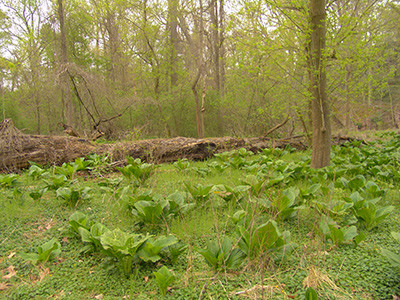
Unique Ecosystem of Skunk Cabbage Hollow
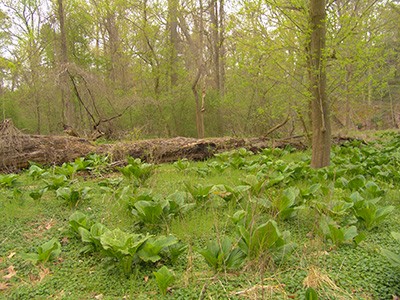 One of the Five Best Preserved Areas in the Crum Woods
One of the Five Best Preserved Areas in the Crum Woods
Late this February, I explored Skunk Cabbage Hollow with Crum Woods Restoration Assistant, Michael Rolli. Of the over 200 acres in the Crum Woods, five unique locations are prominent for their excellent state of preservation: the Wister Forest, Martin Forest, Trillium Slope, Skunk Cabbage Hollow, and the Southern Red Oak Forest.
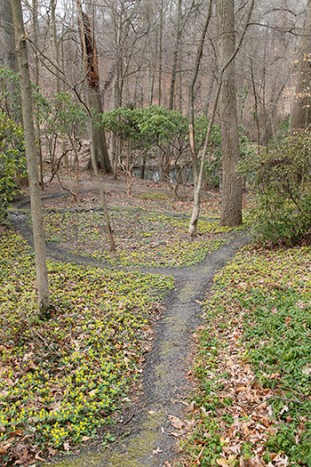
This February, the hillside of Wister Garden was covered in winter aconite, Japanese pachysandra, and snowdrops. photo credit: A. Bacon
These sites have been subject to many pressures of natural areas, such as invasive species competition, deer browsing, trash dumping, and trail use, yet have remained excellent spaces with mature trees, beneficial and endangered species, and wildlife value. Through subsequent blog articles, I will explore each space and share what I’ve learned about its special characteristics, plants, wildlife, and the struggles it faces. I encourage you to visit each beautiful area yourself!
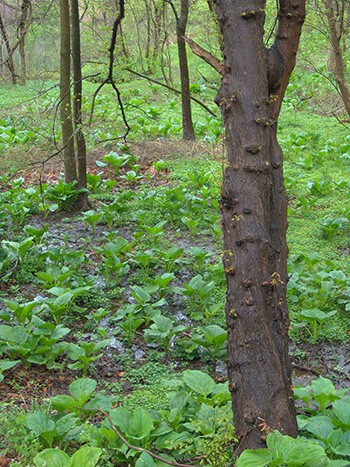
Skunk Cabbage Hollow is a 2.7-acre low-lying, swampy area near Crum Creek, easily accessible from the Wister Garden in the southern portion of the Crum Woods. photo credit: R. Robert
Skunk Cabbage Hollow is a 2.7-acre low-lying, swampy area near Crum Creek, easily accessible from the Wister Garden in the southern portion of the Crum Woods. This February, the hillside of Wister Garden was covered in winter aconite, Japanese pachysandra, and snowdrops.
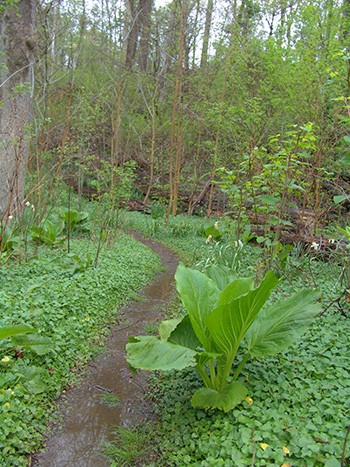
As is typical of many low-lying areas in early spring, we saw the heart-shaped leaves of the invasive lesser celandine leaves carpeting the ground. photo credit: R. Robert
Although these species have ornamental value, they have crept into Skunk Cabbage Hollow and are currently battling for space with our native groundcovers. As is typical of many low-lying areas in early spring, we saw the heart-shaped leaves of the invasive lesser celandine leaves emerging. Gardeners also struggle to eradicate invasive grapevines, porcelainberry, and privet within Skunk Cabbage Hollow.
Despite its struggles with aggressive plants, Skunk Cabbage Hollow remains an invaluable place for wildlife. Because of the plant species that thrive here and the wetland conditions in certain areas, Skunk Cabbage Hollow provides far more wildlife services than many other locations in the Crum Woods.
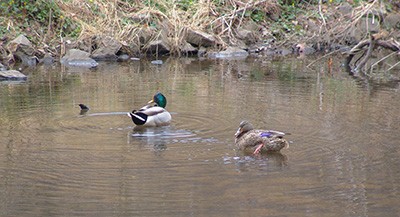
Mallards are often seen swimming in the shallow waters near the bank of Crum Creek. photo credit: R. Robert
Skunk Cabbage Hollow has a robust shrub and herbaceous layer, which is especially beneficial for wildlife searching for cover from predators and shelter for their young. Mallards are often seen swimming in the shallow waters near the bank of Crum Creek. Other bird species also stop by Skunk Cabbage Hollow along their migration route because of the excellent shelter, water, and food it provides.
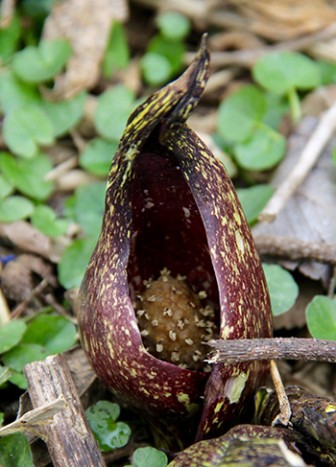
Almost immediately apparent after reaching the creek were the unique flowers of the Skunk Cabbage (Symplocarpus foetidus) which emerge before the skunk-smelling leaves. photo credit: A. Bacon
Almost immediately apparent after reaching the creek were the unique flowers of the Skunk Cabbage (Symplocarpus foetidus) which emerge before the skunk-smelling leaves. The flowers are composed of a modified leaf called a spathe that wraps around the fragile spadix. The spadix is an ovular yellow-green modified stem containing dozens of small flowers.
This remarkable native flower can warm itself while actively flowering, thereby melting the snow that surrounds it, and maintain its temperature at 36° F above the ambient temperature. The spathe of this plant varies greatly and can be any combination of red, purple, green, and yellow, with an interesting spotted pattern.
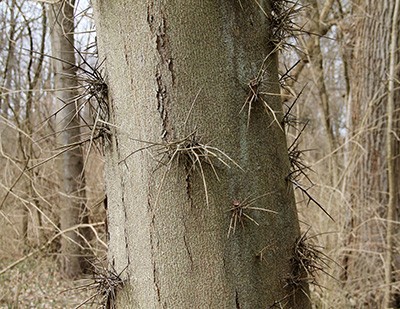
The thorned honeylocust evolved these thorns to deter megafauna (large animals, many of which are now extinct) which would eat its bark and damage the tree while reaching for the large seedpods. photo credit: A. Bacon
Another fascinating plant in Skunk Cabbage Hollow is the thorned honeylocust (Gleditsia triacanthos). In all my horticultural experience, I have never seen a thorned species to rival this tree, with thorns sometimes reaching a length greater than 8 inches. The thorned honeylocust evolved these thorns to deter megafauna (large animals, many of which are now extinct) which would eat its bark and damage the tree while reaching for the large seedpods. Although many of these megafauna disappeared as a result of early human interactions, the thorned honeylocust has kept its thorns.
Mike hypothesizes that the thorned honeylocust is another of the many indications of a American Indian settlement in the Crum Woods. It is well-documented that Ockanickon people had seasonal settlements along the Crum Creek, and a paper published last year that showed that almost every stand of honeylocust in the southern Appalachians corresponds to a historic American Indian settlement. American Indians created weapons and tools using the thorns, and may have planted this tree in Skunk Cabbage Hollow for their use.
Several other species in Skunk Cabbage Hollow are balsam poplars (Populus balsamifera), black willow (Salix nigra), boxelder (Acer negundo), silky dogwood (Cornus amomum), red maple (Acer rubrum), white oak, (Quercus alba), green ash (Fraxinus pennsylvanica), and buttonbush (Cephalanthus occidentalis).
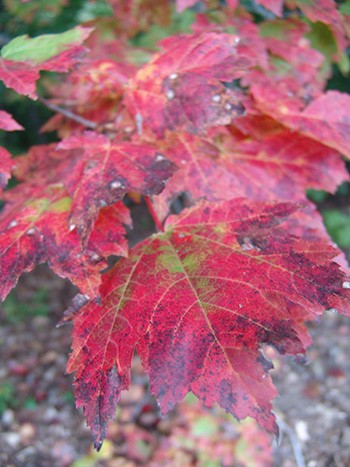
Another specie found in the Skunk Cabbage Hollow is Acer rubrum; seen here in fall color. photo credit: R. Robert
The three mature trees of balsam poplar are the only known stand in Delaware County. It might be the rarest tree in the Crum Woods.
Skunk Cabbage Hollow is the only location in the Crum Woods to find buttonbush and green ash. These plants are typical in wet areas.
Groundcovers and small herbaceous plants in Skunk Cabbage Hollow include rushes, sedges, Joe Pye weed, sensitive fern, smartweed, and, of course, skunk cabbage. Additionally, adjacent to Skunk Cabbage Hollow, Mike found an umbrella magnolia (Magnolia tripetalata) which is endangered in Pennsylvania, evidence of this incredibly important ecosystem.
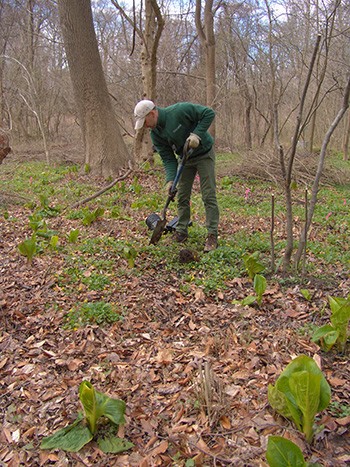
Piles of the invasive privet can be seen behind Gardener Adam Glas while he plants native species in the hollow. photo credit: R. Robert
In the past three years Arboretum volunteers have spent many sessions removing border privet (Ligustrum obtusifolium) and other foreign shrubs. You can see the piles of privet carnage scattered about. About 500 trees and shrubs have been planted in the past two spring plant-outs, including:
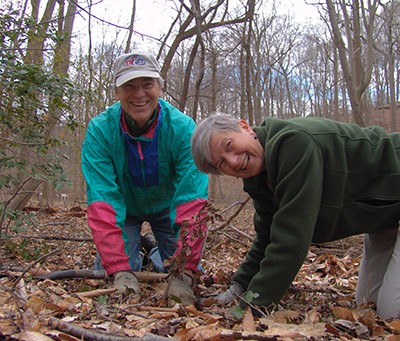
Volunteers Ted Patterson and Ann Ainsworth planting trees during spring plant out in the Crum Woods. photo credit: R. Robert
Asimina triloba (pawpaw)
Prunus serotina (black cherry)
Cephalanthus occidentalis (buttonbush)
Chionanthus virginicus (white fringe tree)
Clethra alnifolia (sweet pepperbush)
Ilex verticillata (winterberry)
Nyssa sylvatica (black tupelo)
Salix exigua (coyote willow)
Salix nigra (black willow)
Salix sericea (silky willow)
Sambucus nigra ssp. canadensis (American elder)
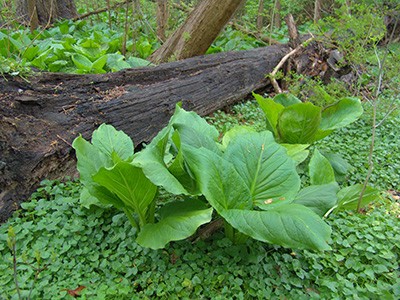
Take some time this spring to explore this unique ecosystem and interact with some of our own native flora and fauna. photo credit: R. Robert
Take some time this spring to explore this unique ecosystem and interact with some of our own native flora and fauna. See if you can find these ecological gems for yourself.





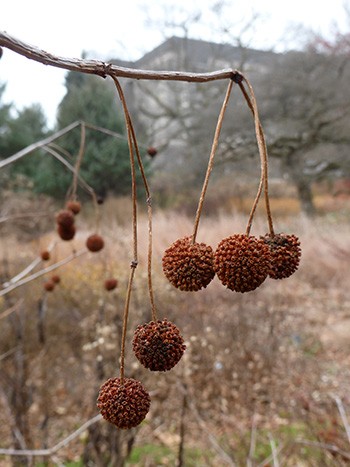
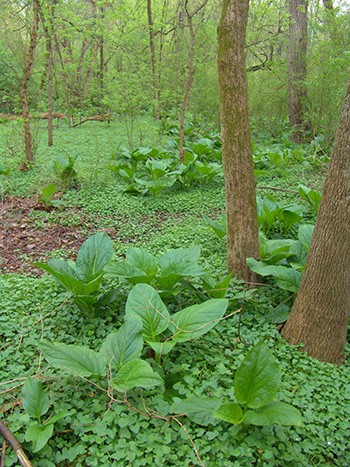
Alan Kruza
Posted at 13:01h, 10 JulyWonderful – please add my name to the distribution list for Garden Seeds. Thank you.
Becky Robert
Posted at 09:16h, 30 JulyThank you Alan. You can subscribe by clicking the subscribe link.
Sincerely,
Becky Robert
Scott Arboretum